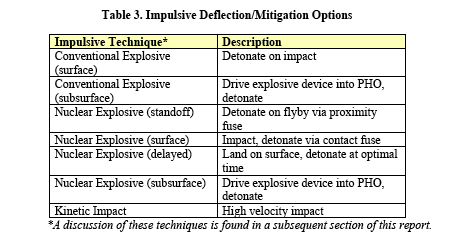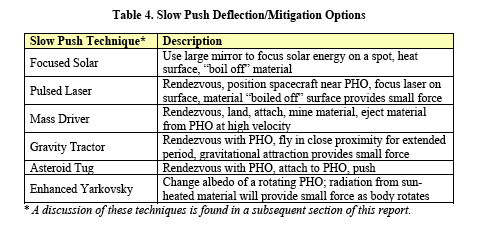



Section 321 of the NASA Authorization Act of 2005 (Public Law No. 109-155), also known as the George E. Brown, Jr. Near-Earth Object Survey Act, directs the NASA Administrator to transmit an initial report to Congress no later than one year after the date of enactment that provides: (1) an analysis of possible alternatives that NASA may employ to carry out the survey program of near-Earth Objects (NEO), including ground- based and space-based alternatives with technical descriptions; (2) a recommended option and proposed budget to carry out the survey program pursuant to the recommended option; and (3) an analysis of possible alternatives that NASA could employ to divert an object on a likely collision course with Earth.
The objectives of the George E. Brown, Jr. NEO Survey Program are to detect, track, catalogue, and characterize the physical characteristics of NEOs equal to or larger than 140 meters in diameter with a perihelion distance of less than 1.3 AU (Astronomical Units) from the Sun, achieving 90 percent completion of the survey within 15 years after enactment of the NASA Authorization Act of 2005. The Act was signed into law by President Bush on December 30, 2005.
A study team, led by NASA’s Office of Program Analysis and Evaluation (PA&E), conducted the analysis of alternatives with inputs from several other U.S. government agencies, international organizations, and representatives of private organizations. The team developed a range of possible options from public and private sources and then analyzed their capabilities and levels of performance including development schedules and technical risks.
The goal of the Survey Program should be modified to detect, track, catalogue, and characterize, by the end of 2020, 90 percent of all Potentially Hazardous Objects (PHOs) greater than 140 meters whose orbits pass within 0.05 AU of the Earth’s orbit (as opposed to surveying for all NEOs).
The Agency could achieve the specified goal of surveying for 90 percent of the potentially hazardous NEOs by the end of 2020 by partnering with other government agencies on potential future optical ground-based observatories and building a dedicated NEO survey asset assuming the partners’ potential ground assets come online by 2010 and 2014, and a dedicated asset by 2015.
Together, the two observatories potentially to be developed by other government agencies could complete 83 percent of the survey by 2020 if observing time at these observatories is shared with NASA’s NEO Survey Program.
New space-based infrared systems, combined with shared ground-based assets, could reduce the overall time to reach the 90 percent goal by at least three years. Space systems have additional benefits as well as costs and risks compared to ground-based alternatives.
Radar systems cannot contribute to the search for potentially hazardous objects, but may be used to rapidly refine tracking and to determine object sizes for a few NEOs of potentially high interest. Existing radar systems are currently oversubscribed by other missions.
Determining a NEO’s mass and orbit is required to determine whether it represents a potential threat and to provide required information for most alternatives to mitigate such a threat. Beyond these parameters, characterization requirements and capabilities are tied directly to the mitigation strategy selected.
The study team assessed a series of approaches that could be used to divert a NEO potentially on a collision course with Earth. Nuclear explosives, as well as non-nuclear options, were assessed.
Nuclear standoff explosions are assessed to be 10-100 times more effective than the non-nuclear alternatives analyzed in this study. Other techniques involving the surface or subsurface use of nuclear explosives may be more efficient, but they run an increased risk of fracturing the target NEO. They also carry higher development and operations risks.
Non-nuclear kinetic impactors are the most mature approach and could be used in some deflection/mitigation scenarios, especially for NEOs that consist of a single small, solid body.
“Slow push” mitigation techniques are the most expensive, have the lowest level of technical readiness, and their ability to both travel to and divert a threatening NEO would be limited unless mission durations of many years to decades are possible.
30-80 percent of potentially hazardous NEOs are in orbits that are beyond the capability of current or planned launch systems. Therefore, planetary gravity assist swingby trajectories or on-orbit assembly of modular propulsion systems may be needed to augment launch vehicle performance, if these objects need to be deflected.
The following tables provide a summary of the options considered. Technical descriptions of each option, as well as other combinations of alternatives, can be found in subsequent sections of this report. For each option, Table 1 shows the percentage of PHOs that would be found by the survey by the end of 2020 and the year each option would achieve 90 percent completion, starting with the option of sharing the use of potential ground-based observatories, which will be referred to as the “Reference” architecture through the rest of this document. Details regarding the availability of assets for each option are also found in subsequent sections. Table 1 shows that individually each of the first three options fall short of meeting the Congressional goal. As shown in the last line of Table 1, the minimum survey architecture that achieves the goal would be a combination of the shared ground-based assets plus one of two dedicated asset options.




Currently, NASA carries out the “Spaceguard Survey” to find NEOs greater than 1 kilometer in diameter, and this program is currently budgeted at $4.1 million per year for FY 2006 through FY 2012. We also have benefited from knowledge gained in our Discovery space mission series, such as the Near Earth Asteroid Rendezvous (NEAR), Deep Impact, and Stardust missions that have expanded our knowledge of near-Earth asteroids and comets. Participation by NASA in international collaborations such as Japan’s Hayabusa mission to the NEO “Itokawa” also greatly benefited our understanding of these objects. NASA’s Dawn mission, expected to launch in June 2007, will increase our understanding of the two largest known main belt asteroids, Ceres and Vesta, between the planets Mars and Jupiter. NASA conducts survey programs on many celestial objects - the existing Spaceguard program for NEOs, surveys for Kuiper Belt Objects, the search for extra-solar planets, and other objects of interest such as black holes to understand the origins of our universe. Our Discovery mission series in planetary science may offer additional opportunities in the future beyond our current survey efforts.
NASA recommends that the program continue as currently planned, and we will also take advantage of opportunities using potential dual-use telescopes and spacecraft - and partner with other agencies as feasible - to attempt to achieve the legislated goal within 15 years. However, due to current budget constraints, NASA cannot initiate a new program at this time.